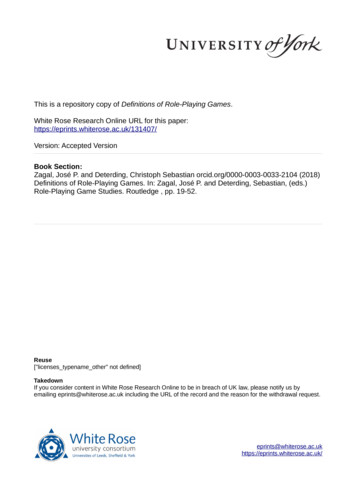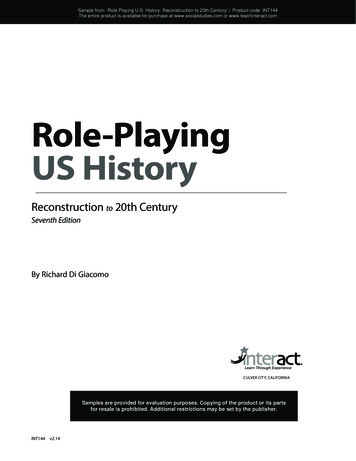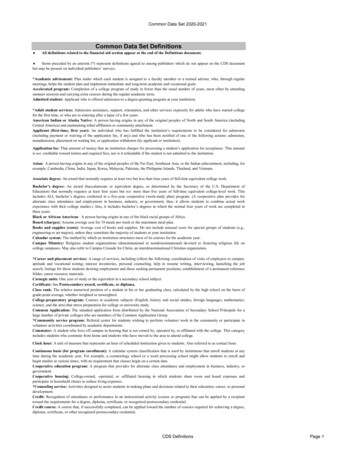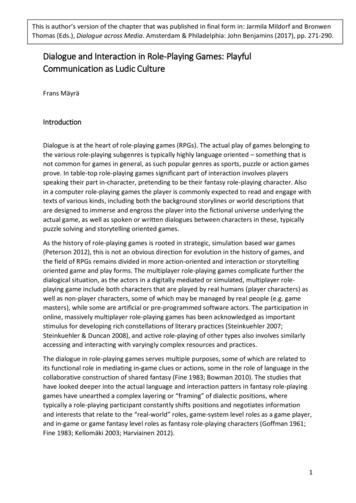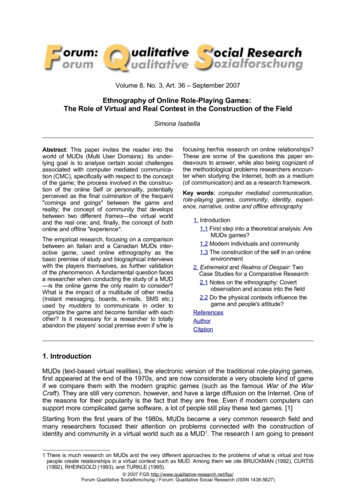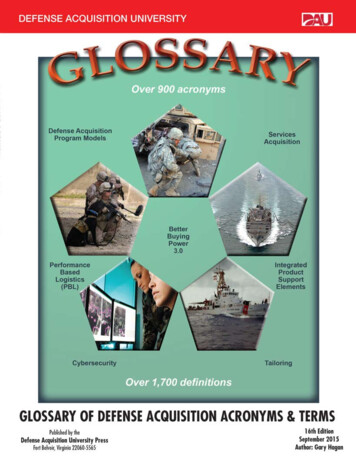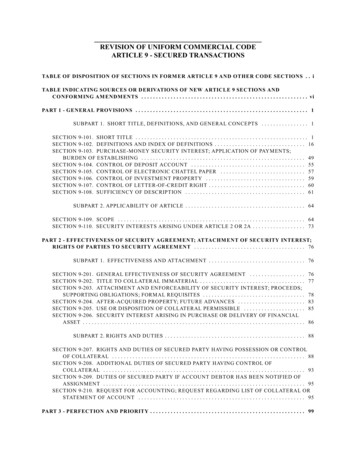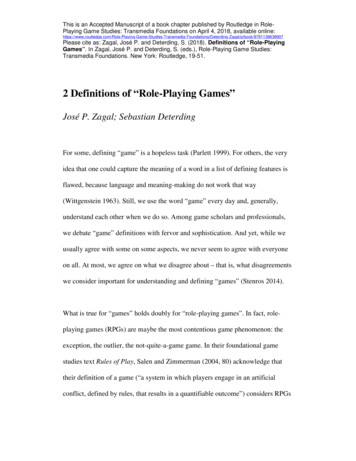
Transcription
This is an Accepted Manuscript of a book chapter published by Routledge in RolePlaying Game Studies: Transmedia Foundations on April 4, 2018, available book/9781138638907Please cite as: Zagal, José P. and Deterding, S. (2018). Definitions of “Role-PlayingGames”. In Zagal, José P. and Deterding, S. (eds.), Role-Playing Game Studies:Transmedia Foundations. New York: Routledge, 19-51.2 Definitions of “Role-Playing Games”José P. Zagal; Sebastian DeterdingFor some, defining “game” is a hopeless task (Parlett 1999). For others, the veryidea that one could capture the meaning of a word in a list of defining features isflawed, because language and meaning-making do not work that way(Wittgenstein 1963). Still, we use the word “game” every day and, generally,understand each other when we do so. Among game scholars and professionals,we debate “game” definitions with fervor and sophistication. And yet, while weusually agree with some on some aspects, we never seem to agree with everyoneon all. At most, we agree on what we disagree about – that is, what disagreementswe consider important for understanding and defining “games” (Stenros 2014).What is true for “games” holds doubly for “role-playing games”. In fact, roleplaying games (RPGs) are maybe the most contentious game phenomenon: theexception, the outlier, the not-quite-a-game game. In their foundational gamestudies text Rules of Play, Salen and Zimmerman (2004, 80) acknowledge thattheir definition of a game (“a system in which players engage in an artificialconflict, defined by rules, that results in a quantifiable outcome”) considers RPGs
a borderline case. While RPGs are widely recognized for their influence on manyother games (e.g. Tychsen 2006), they are apparently not game enough becausethey lack a quantifiable outcome (Salen and Zimmerman 2004, 81). Jesper Juul,author of another influential game definition, likewise considers tabletop RPGs aborderline case: they are “not normal games because with a human game master,their rules are not fixed beyond discussion” (Juul 2003).To make matters worse, “role-playing games” refers to a plurality of forms acrossmedia – there are tabletop RPGs, computer RPGs, (massively) multiplayer onlineRPGs, live-action RPGs, and more. Do these different forms have ‘enough’ incommon to all be called “role-playing games”? Furthermore, there are manydifferent communities discussing the definition of “role-playing games”, eachwith different practical ends: game designers and publishers use the word in gamemanuals, sales venues, trade publications and conference talks to set consumerexpectations and discuss design issues; fans discuss RPGs in fan media; scholarsdiscuss RPGs in the contexts of research and teaching. RPG fans and designershave long observed the existence of quite different styles and ends of playingRPGs – focusing e.g. on storytelling, playing a role, simulating a world, orachieving goals and progress according to rules (see chapter 10). This opennessto divergent preferences and enactments seems characteristic for RPGs. Forinstance, different cultural regions have developed distinct flavors like “Nordic
larp” (Stenros and Montola 2010). Existing forms are constantly remade andredefined by avant-garde movements like “indie” tabletop RPGs. What’s more,game research is itself notoriously multidisciplinary, looking at games – andRPGs – through many different theoretical and disciplinary lenses (Deterding2016).[Box Insert 2.1 here]Different forms, communities, design and play styles, cultures, historicalmoments, disciplines: all these contribute to the difficulty of defining “roleplaying games”. Yet we believe that a crucial reason why people haven’t beenable to settle on a shared definition is the – largely unreflected – way in whichthey have tried to do so. For as linguistics and philosophy tell us, there are manyways of defining things, some outmoded, many only appropriate for specificpurposes, and all laden with consequential assumptions, decisions, and implicitvalues.To clarify the definitions of “role-playing games”, we therefore first survey thedifferent forms and understandings of definitions. We argue that how scholarshave traditionally tried to define “role-playing games” – as a presumedunchanging ‘essence’ consisting of a set of shared features – is at odds with what
we know about language and meaning-making, and with the kind of phenomena“role-playing games” refer to. We present an alternative pragmatist position thatallows for a plurality of definitions as explicit (disciplinary) perspectives andtools. We then proceed with what we identify as a useful task for disciplinaryspanning work: clarifying discourse by empirically describing who is using theword “role-playing games” how. We do so by discussing four commonlydistinguished forms of RPGs: tabletop, live-action, single-player computer, andmultiplayer online RPGs. For each, we tease out: how they have been defined by scholars, designers, and fans, as these are thethree main social groups producing and circulating definitions; what empirical phenomena these groups have pointed at with the word “roleplaying games” and what characteristics reoccur across these phenomena; where these characteristics historically originated; and how they evolved over time and what kind of variation we see.Finally, we tease out common characteristics across forms of RPGs, as well ascharacteristics of the discourse about them. We argue that joint ancestry in earlytabletop RPGs can explain at least part of the shared characteristics of the thingspeople call “role-playing games”. The divergence of multiple forms of RPGs inturn stems from the affordances of their socio-material assemblages: what form ofplay they make easy or hard to accomplish. Because RPGs are social not natural
entities and relatively underdetermined, they show such a wide and growingdiversity of forms and play styles.[Box Insert 2.2 here]Defining “definitions”Definitions are usually seen to state the reference and meaning of a word orconcept, to specify its extension and intension (Baumann 2002). Extension is theset of phenomena a word refers to, e.g., “game” refers to all the actual games thatexist. Intension is the meaning of the word stated as a set of properties all andonly instances of that essence share – e.g., what is the “heart of gameness” (Juul2003) that makes all games games? What list of properties allows us to tellwhether something counts as a game?Definitions in game studies usually align with this tradition, taking the form “X isa Y with the properties Z1, Z2, , Zn”, e.g. “a game [X] is a system [Y] in whichplayers [Z1] engage in an artificial conflict [Z2], defined by rules [Z3], thatresults in a quantifiable outcome [Z4].” (Salen and Zimmerman 2004) Thisclassical conception of definitions – dating to Aristotle and Plato – is sometimescalled a genus-differentia definition, because it defines X as a specific kind of a
larger category or genus (here: a system) that is distinct from other kinds in thiscategory by some differentiating properties or differentia (here: players, artificialconflict, etc.) (Margolis and Laurence 2014; Gupta 2015). Although intuitive,there is significant evidence in psychology and linguistics that concepts andwords do not work as the classical conception suggests (Baumann 2002; Margolisand Laurence 2014).Scholars have proposed numerous alternatives (see Margolis and Laurence 1999for a collection). Wittgenstein (1963) for instance held that there is no set ofnecessary and sufficient properties shared by all and only those phenomenapeople call “games”. This was not a statement specific to games. Rather,Wittgenstein used games as an example for a general argument about languageand meaning. Wittgenstein’s family resemblance model argues that each thing aword refers to shares many properties with other things that word refers to, but nosuch properties are shared by all and only those things. Given this plurality oftheories of concepts and their meanings, each with varying support, any scholarlydefinition should, with reason, be able to state which theory it subscribes to andwhy. Yet most current definitions of RPGs don’t.Which brings us to a second unspoken assumption: What kind of definition are wemaking? To mention common distinctions (Gupta 2015): There are stipulative
definitions, used to introduce a new concept (e.g. “zlorch is a unit of X”) orclarify the use of an existing one, e.g. “I here use ‘game’ to mean any conflictbetween two or more parties”. Nominal definitions try to capture the meaning anduse of a word (as done in a dictionary), and real definitions try to capture theproperties of the phenomena the word refers to. Closely linked to that is theanthropological distinction between emic and etic accounts (Headland, Pike, andHarris 1990): Emic accounts state the views, concepts, understandings of a givenculture: “these people call these things RPGs”. Etic accounts present views andconcepts of the observing researcher: “they call these ‘RPG’s, but I call them‘socially-focused play experiences’”. So, when examining existing definitions, itis important to understand what kind of definition is being proposed and whatpurpose it is attempting to serve.A third assumption: Of what “stuff” are concepts, words, and the things they referto made? The two most relevant considerations for our purposes are whether roleplaying games are natural or social entities, and connected to that, whether theyare natural kinds. Natural entities are things described by the natural sciences,like bees, quasars, or magnetism, and seen to exist independent of human actionand meaning-making. Natural kinds are groupings of natural entities that reflectthe structure of the natural world rather than the structure of human interests,actions, and understandings (Bird and Tobin 2015). In contrast, social entities like
divorce, crime, or money are brought into existence by human action andmeaning-making (e.g. Searle 1995). For instance, chemical elements like gold andsilver are natural kinds that show the same observable properties in every context,whereas what counts as a “precious metal” and what can be done with it dependson local social contexts of human action and meaning.This doesn’t mean that social entities are “less real” or “less sturdy” than naturalentities. Just like chemistry describes the chemical processes through whichhydrogen and oxygen combine to produce water, the social sciences describe thesocial processes – how people act, talk, and shape their material environment –that produce the sturdy entities we call “government”, “money”, or “crime”(Hacking 1999). Because these entities are made of social processes, scientificdescription can affect the entities described: a psychologist defining a behavior as“mental illness” and classifying someone as “having” that illness affects how weunderstand and treat that person. With natural kinds, whether something belongsto that kind can be settled empirically. With social categories, whether somethingbelongs to it is determined by the agreement of that society’s actors. A socialcategory is its practical use (Bowker and Star 2000). As a result, social entitiesexhibit historical change and cultural variation: Swedes and Japanese mayconsider what is “embarrassing” different from each other as well as theirancestors from 100 years ago.
The point is that some game definitions imply that “games” are a natural kindwhile a number of game scholars have recently argued that games are social (orsocio-material) entities (Montola 2012; Deterding 2014; Stenros 2015). Arguably,RPGs foreground this social constitution of games. In TRPGs and larp, it isreadily apparent that people talk and act a given game and game world into being– when people stop enacting it, the game ceases to exist. In contrast, board gamescontinue to exist as physical objects people can point to and call “game” evenwhen the game is not being played. Defining games as social entities implies thatthey are subject to historical change and cultural difference. Thus, gamedefinitions can only tease out “what games are” for a given social group at agiven point in time. It also means that we have to specify what social entity theyare. The word “role-playing games”, like “games”, is used to denote both objectsand activities (Hitchens and Drachen 2009). There has been an analogous splitbetween definitions of role-play and definitions of role-playing games (ibid.).Any definition is always an abstraction: the map, not the territory. As such, itforegrounds certain aspects as relevant and ignores or de-emphasizes others. Whatis considered as relevant is always informed by some human concern. AsBateman (2015) pointed out with regard to game definitions, “every definitionmarks out some subset of phenomena as being of specific interest to its topic and
thus involves some kind of value judgment”. This leads to another unspokenassumption of most definitions: From what (disciplinary) perspective are welooking at the phenomenon in question?Now to some extent, academic disciplines are constituted by what they considerworthy of concern. This concern informs what their theories look like, how theworld appears to them – and consequently, what ends up being the starting termor genus of their definitions. An economist is concerned with how goods andservices are produced, distributed, and consumed. So, when asked to define “roleplaying games”, she might state: “It is a good, specifically, anentertainment/hedonic/experiential good with the properties x, y, z”, or “it is aneconomy, specifically a virtual economy” (see chapter 16). To an educationalresearcher – concerned with human learning – role-playing games would appear(and be defined) as a specific site or form of learning (see chapter 15). The factthat current popular game definitions (e.g. Juul 2003; Salen and Zimmerman2004) present “games” as systems reflects the concerns and preconceptions oftheir authors, namely design, systems theory, and formal literary studies.Similarly, Malaby’s suggestion (2007) that we understand “games” as processes,practice, or cultural domains reflects his anthropological concerns andpreconceptions.
We can also consider definitions without a basis in the constructs of an existingdiscipline. RPG definitions using everyday language – in rulebooks, fandiscourse, or academic texts – typically cast RPGs as an analogy to or deviationfrom an existing cultural form: RPGs are a form of play/ fiction/ game/storytelling/ drama/ simulation/ art/ literature/ etc. (see Simkins 2015 for aninstructive example). This is practical as it provides an immediate, rich mentalmodel to work from: “It’s like improv theater, only you sit at a table and describewhat your character does” immediately conjures a mental image with richinferences. However, like disciplinary perspectives, it necessarily reduces thecomplexity of the phenomenon in some way and embodies what Bateman (2015)called “implicit game aesthetics” and fan theorists “creative agenda” (Edwards2004): RPGs can be realized in distinct styles or desired experiences, e.g. gamismor playing a rule-based game to win, dramatism or theatrically embodying andenacting a character, narrativism or telling an interesting story together, orsimulationism or creating a realistic simulation of a world. Thus, to define RPGsas “an act of shared story-creation” implies a normative value judgment that“good” or “real” RPGs emphasize storytelling over e.g. gaming or dramatic roleenactment.These implicit aesthetics may be why definitional debates quickly becomecontentious and are hard to resolve: they necessarily entail abstractive reductions
and value judgments. As individuals, we have usually been socialized into someforms and styles of RPGs earlier and/or more thoroughly than into others, andhave developed personal aesthetic preferences. Hence, the reference set ourintuition draws upon to check whether a given definition ‘makes sense’ or not,whether it captures every feature we ‘feel’ is important, and whether itincludes/excludes everything we ‘feel’ should be included/excluded, isnecessarily partial and biased towards that personal set of experience and taste.We point this all out to reiterate that defining something entails decisionsregarding importance (i.e. value judgment regarding what is worthy of attention),some (theoretical) language, and thus some reductive translation of the definedphenomenon. To summarize, defining something implies: a semiotics – a theory of how concepts and meaning-making work, andhow they hang together with reality, knowledge, and words; a type of definition – a specific way of defining something; an ontology – a theory of what being is and what stuff reality is made of; a perspective and language – a focus on some phenomena as worthy ofconcern, and some (conceptual) language appropriate for articulatingthem.
So, how can we construct an interdisciplinary definition of “role-playing games”?One strategy is to devise a transdisciplinary grand unified theory that canarticulate the concerns of any individual discipline (Deterding 2016). Yet no suchgrand theory has been forthcoming in game research. A second strategy – whichwe adopt here – is to allow a pluralist dialogue of human concerns anddisciplinary perspectives. Instead of defining “what ‘role-playing games’ are”, weask: “What useful questions can be phrased, what helpful things are observable ifwe see role-playing games as insert disciplinary perspective X here ?” Thismove from “is” to “as” allows for multiple perspectives without forsaking rigor. Itdemands that every perspective explicitly articulate the (theoretical, semiotic,ontological) stance from where it speaks; that it argue effectively why this stanceis productive for answering its concerns; and that it maintains rigor within its ownstance. To enable this pluralist dialogue, the chapters in section III (Chapters 1019), each articulate a perspective on RPGs from a discipline that has concerneditself with them in some way.Our pluralist strategy also leaves space for joint foundational work that clarifies,empirically, what we talk about when we talk about “role-playing games”. True toour own demands, we note that this strategy is epistemologically pragmatist: Itviews scientific disciplines, theories, concepts, and definitions as tools for solvinghuman problems, and measures their validity by their practical consequences
(Haack 2004). It acknowledges that other stances are possible and possibly useful.Ontologically, we assume that the phenomena called “role-playing games” (likewords or science) are human creations and therefore at least partially constitutedby joint action, talk, and shaping of material artifacts: “Role-playing games” is asocial not natural entity, and thus not a natural kind. 1 Semiotically, we subscribeto the pragmatist notion of meaning as use settled by a language communitywithin a shared life world. We also state properties frequently reoccurring acrossdefinitions and phenomena people have called “role-playing games”, since allcurrent non-classical theories of concepts employ them in some central way. Inshort, our goal is to provide an empirical transmedia explication of how the word“role-playing games” has been defined and what phenomena it has been used torefer to.Forms of Role-Playing GamesWhen scholars, designers, and fans use the words “role-playing games”, theytypically don’t speak about all phenomena called “role-playing games”, butusually refer to one of several clusters of phenomena, which we here call forms(Dormans 2006; Hitchens and Drachen 2009). In this book, we focus on four
prominent forms: tabletop, live action, (single-player) computer, and multi-playeronline RPGs.Tabletop RPGs (TRPGs), usually played by a group sitting around a table, arearguably the common ancestor of all forms. Players typically each create and thencontrol a fictional character within a shared fictional game world, maintainingcharacter information (possessions, specific abilities, etc.) on a piece of paper –commonly called a character sheet. 2 Player characters’ abilities are generallyquantified (e.g. strength is 15, driving skill is 12). One special player, called thereferee, game master, judge, dungeon master or similar, is the arbiter and managerof the game. The referee enforces the rules of the game, enacts the fictional worldby telling the players what their characters perceive and what the non-playercharacters (NPCs) do. Players verbally describe what they want their charactersto do, and the referee tells them the results of those actions – typically using acombination of improvisation and the game’s rules where dice are often used todetermine the outcome of certain actions.[Box insert 2.3 here][Box insert 2.4 here]
From this, perhaps the easiest way to describe live-action role-playing (larp) is toimagine a TRPG where players embody and act out their character’s actionsrather than verbally describing them. As in TRPGs, not all participants areplayers; some might be referees while others may play the parts of NPCs –“supporting roles” who receive instructions and information from the referees toguide the flow of events. Rules are still used to govern the success of in-gameactions, though they are often simpler and more embodied than those of TRPGs.For example, they might use versions of rock-paper-scissors or rules-of-thumblike “your character can do what you can do” to decide the outcome of uncertainactions.Computer role-playing games (CRPGs) can be described as tabletop RPGs thatare played alone on a computer: one player controls all player characters and thecomputer enacts the referee, displaying the game world through monitor andspeakers. Their rules are often similar to those in tabletop games, though manyCRPGs involve real-time play testing the player’s reflexes. CRPGs are arguablydistinguishable from tabletop games in that they enable easy single-player play,emphasize storylines and rules which can become much more complex andinvolved as they are maintained by the computer, and usually don’t afford roleplaying in the sense of dramatically empathizing, embodying, and acting out acharacter (Hitchens and Drachen 2009).
Multiplayer online role-playing games (MORPGs) can be thought of as tabletopgames where players log in to a computer who handles all of the usual refereeresponsibilities. Conversely, they could be considered multiplayer CRPGs whereplayers play together in a shared world online, each controlling only onecharacter. In MORPGs the fictional game world is persistent: it continues to existand change even when (individual) players are not logged in. They also oftenallow for the co-existence of a massive numbers of players, in which case they areusually called massively multiplayer online role-playing games (MMORPGs). Aswith CRPGs, there is usually an emphasis on rules and systems, often borrowedfrom TRPGs, rather than on the role-playing.Again, with “forms” we don’t mean natural kinds: they are distinctions peoplemake in and through talk, action, and shaping of material artifacts. Consequently,different people distinguish and list different forms. Hitchens and Drachen (2009)for instance list freeform, systemless, and pervasive as additional forms. In thepresent book, Chapter 8 describes online freeform as another emerging RPGform. We highlight these four because their distinct reality is widelyacknowledged by scholars, designers, and fans; they have had significant culturalimpact through their historical role and size of player audience; each has sparkedits own definitional debates; and formal etic analyses suggest that the phenomena
subsumed under each of these labels indeed share characteristics that differ fromthose bunched under the other labels (e.g. Dormans 2006; Hitchens and Drachen2009). Obviously, there are variations, exceptions, and debates within each form:Is a tabletop RPG with no rules “still a tabletop RPG”? If a computer role-playinggame has a human referee, is it “not actually a tabletop RPG”? And so on.We will now (1) briefly sketch the historical provenance of each form, (2) provideinfluential definitional attempts, (3) list characteristic features of that form and (4)highlight common deviations and innovations from that list. Our historical sketchis consciously reductive and partial: we have chosen TRPGs as the ancestor andwill trace the other forms through the lens of how they evolved and differentiatedthemselves from TRPGs. There are other lenses we could have considered (e.g. asacts of collective pretend play, theater, simulation, gaming, storytelling). Wefocus on the shared lineage from tabletop RPGs because it helps socio-culturallyunderstand how and why the different forms differ and don’t.Tabletop Role-Playing GamesIn 1974, a small company called Tactical Studies Rules, later known as TSR,published Dungeons & Dragons (D&D, Gygax and Arneson 1974a). It was anunassuming box containing three slim booklets whose cover described its contentsas “Rules for Fantastical Medieval Wargames Campaigns Playable with Paper
and Pencil and Miniature Figures” (Gygax and Arneson 1974b). The game wasnot only closely modeled on its ancestor – miniature wargaming (Peterson 2012)– but also labeled itself as such.And yet, Gygax and Arneson’s introduction to D&D already highlightedcharacteristics that, while not individually innovative, when taken together, led toit being considered as a new type of game (Peterson 2012). It was an open-endedgame for which “your time and imagination are about the only limiting factors”(Gygax and Arneson 1974b). Its rules were “guidelines to follow” [emphasis inoriginal]. D&D also required a referee who had to prepare “dungeons” – ascenario set in a fictional game world, typically a cave or castle in a fantasy worldfilled with adversarial monsters and traps as well as treasures. Players could eachdecide what individual character or role they wanted to play and then create andgovern the actions of that character. Player characters could improve their abilitiesand “work upwards” as they gained “experience” measured in “experiencepoints”. And the referee would present and govern the events and entities of thegame world (Gygax and Arneson 1974b).While TRPGs – in contrast to war games or board games – gave players unlimitedfreedom in imagining what their characters might attempt to do, whether theseactions succeeded or not was constrained and adjudicated by rules and the whims
of the referee. As Mackay put it in his definition, there are “rules that assist agroup of players and a gamemaster in determining how their fictional characters’spontaneous interactions are resolved” (Mackay 2001, 5). For this task resolution(see chapters 10, 18), D&D utilized many conventions of miniature war games ofits time: combat was the (almost exclusive) concern. Rules modeled charactersand decided their actions probabilistically: a combatant was described bynumerical traits like level, strength, or “hit points”, and these traits determined theprobability of a certain action succeeding, usually resolved with dice rolls.One characteristic novel rule component D&D introduced were systems forcharacter progression (Peterson 2012), that is, rules and game mechanisms thatdefine how player’s characters improve from one game session to the next (Zagaland Altizer 2014). Character progression is one of the primary rewards of tabletopRPGs (Fannon 1999). “[I]n most role-playing games, players maintain theircharacters from session to session, using them again and again. Gradually theplayer characters’ skills increase. They become more powerful and betterequipped and undertake more difficult tasks to maintain the challenge of thegame” (Schick 1991).As in wargames, players and referee sat around a table, using a printed rulebookwith rules, tables, dice, and character sheets. An individual quest or adventure –
the looting of a dungeon – could take several sessions of multiple hours ofplaytime. Individual adventures could be connected together into a campaign bythe progressing characters, a shared fictional world, and even an overarching plot.Referees could create adventures, campaigns, and worlds, but TSR (and othercompanies) also published adventures, campaigns, and books detailing wholefictional worlds. D&D and other early TRPGs were often adversarial (Appelcline2014a, 347–348): players had to watch for traps and survive the challengesthrown at them by their referee. This quickly shifted towards a collaborativeexperience where players and referee worked together for the enjoyment of all(e.g. Plamondon 1982).In contrast to the often historical settings of wargames, and in tune with thepopularity of fantasy and science fiction literature in the 1970s, most early TRPGswere set in some “medieval fantasy” world. As a result, TRPGs are often viewedas a unity of form and content and were often alternatively called “fantasy roleplaying games”. Yet as the TRPG market grew, it expanded into differentsettings: cowboys, spacefaring humans, post-apocalyptic mutants, and others.Still, TRPG settings have largely remained limited to some form of genre fiction,including established franchises (Star Wars, Star Trek, Middle Earth), and genrecombination like fantasy-cyberpunk or horror-western. However, the rise of
“indie” TRPGs in the early 21st century (see chapter 10) demonstrated that thebasic aesthetic form of TRPGs was amenable to all kinds of subject matter.As a new phenomenon, TRPGs could not rely on people’s shared culturalknowledge of what they were or how to play them. They also could not rely onthe game artifacts to guide and constrain play: games like D&D consisted ofnothing more than prin
Definitions of "Role-Playing Games". In Zagal, José P. and Deterding, S. (eds.), Role-Playing Game Studies: Transmedia Foundations. New York: Routledge, 19-51. 2 Definitions of "Role-Playing Games" José P. Zagal; Sebastian Deterding . For some, defining "game" is a hopeless task (Parlett 1999). For others, the very



